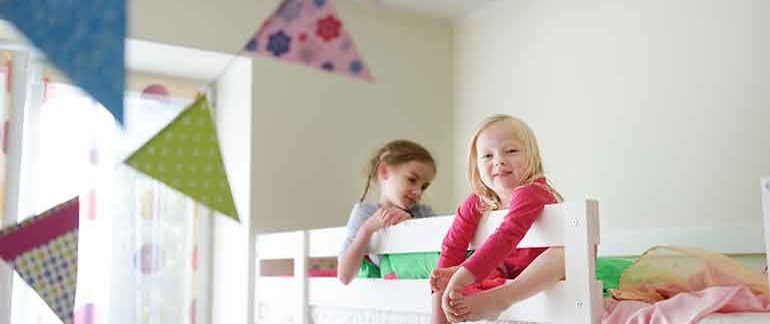
Tips for Keeping the Peace when your Children Share a Bedroom
March 18, 2018 | Family Life
When your children share a bedroom it can go in two directions. A shared bedroom can either be a source of endless fighting, or it can lead to good memories and bonding between siblings. Can you prevent one and encourage the other? Is it even possible to influence your kids’ relationship? In a word, yes.
While you can’t change your kids’ personalities, you can design a room that makes space for both privacy and togetherness. This balance between individuality and sharing will encourage respect and help your kids enjoy their shared space.
Finding this balance can be difficult at first. However, it gets easier over time, especially once you’ve found a room design that works. Here are a few ways you can create a shared kids’ bedroom that everyone loves.
Plan the Room’s Layout
Before you start buying furniture or moving everything into the room, it’s helpful to have a clear picture of how everything will be organized. In particular, you should think about which parts of the room will be shared or private.
One easy way to imagine a shared and private space is to draw a diagram of the room, including the furniture you’re planning to use. Then, draw bubbles around the spaces that each child will use for playing, sleeping, etc. The two bubbles will overlap in certain areas—these spaces will be shared. Any area with only one bubble will be private.
There’s no ideal layout for all kids. Some kids do great with a lot of shared space. Others need large private spaces (and few shared spaces) to feel comfortable. Adapt the room to your kids’ personalities, creating more or less private space according to their needs.
Respect Each Child’s Private Space
When setting up the room, make sure each child understands which areas are shared, and which are private. Depending on the room’s layout, you could even make the separation obvious with a “border” or isolated spaces. For example, you could use a bookcase or wardrobe to create a cozy nook or to shield the bed from view.
Ideally, each kid should have a place with absolute privacy, hidden from their sibling’s view. Then, if they ever need to “get away” from their sibling, they have someplace to go. If the room is tiny, try to create privacy by hanging a curtain or building a “wall” around each bed.
Once these private spaces are clear, lay down a strict rule about respecting each private space. Everyone in the family—including the parents—should respect these areas.
In other words, if you’re tidying up the room, don’t place anything in the private space. Instead, use a shared basket or box for random stuff you or the kids pick up. This basket/box will help protect each kid’s privacy, as well as corral their things into one place.
Create a Pleasant Shared Space
While private spaces are important, your kids may end up spending a lot of time in their shared spaces, too. These areas are where the kids will play, talk, and study together. When children share a bedroom there can be more conflict. It can also create the foundation of a good relationship.
Regardless of your kids’ personalities, you can create a shared space that works well for both. They may be opposites in many ways—girl/boy, loud/quiet, tidy/messy—but a well-designed shared space can bring out the things they have in common. In this way, by focusing on what they both like, the shared space can encourage more harmony and friendship.
When children share a bedroom it’s important to honor individuality. Start off by choosing a pattern or color scheme that everyone likes. For instance, you can focus on geometric shapes or gray and yellow colors. This theme will help make decorating the shared space easier and more fun for both.
You can also add decorations that connect the kids and show their relationship. For example, you can hang photos of the kids together or frame both of their newborn footprints. If they both have souvenirs from a family vacation, you can place those in the shared space.
Another way to create a connection is to give the shared space a “purpose.” For instance, it could be a study area with two desks for doing homework. Or you could create a gaming area with games for two players or more.
No matter what you choose, it’s crucial to get the kids involved. For example, you can ask each of them to create or choose one piece of art for the walls. Even if you limit their choices, they should feel like they helped create the shared space.
Make Room for Storage
If your children share a bedroom, space gets used up quickly with two kids. You’ll want to maximize your space in every way possible, from multifunctional furniture and extra shelving to organization containers for each of your children. Use vertical space to the limit; you can even put things above the door!
Storage space is especially useful in shared kids’ bedrooms with mixed genders or big age differences. Storage containers can keep certain toys out of sight or out of reach, while also making the room look more attractive. This way, the toddler won’t destroy the older kid’s toys, and the boy won’t feel embarrassed by the girl’s pink princess toys.
Make More Space with a Unit from Metro
Of course, when two children share a bedroom things can get messy. Chaos is inevitable with two kids, but extra storage space—as well as regular tidying up—can help keep it under control.
If the room still feels cramped, consider getting a self storage unit for things they don’t need every day, like out-of-season clothes and toys. Even a small storage unit can make a big difference in how the room feels. It’ll give your kids more room to breathe, play, and enjoy each other’s company.



